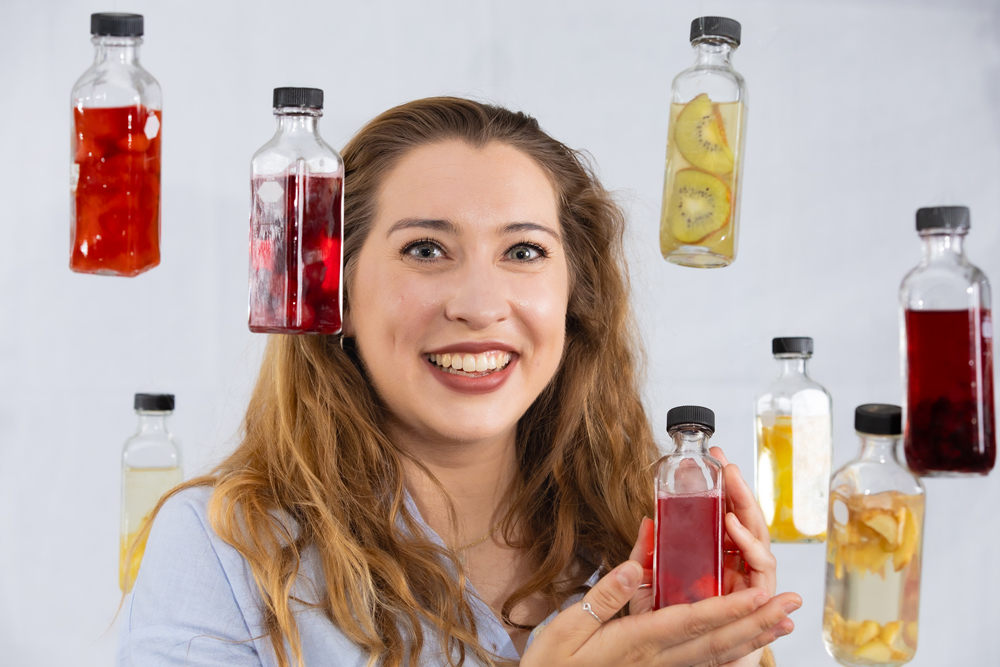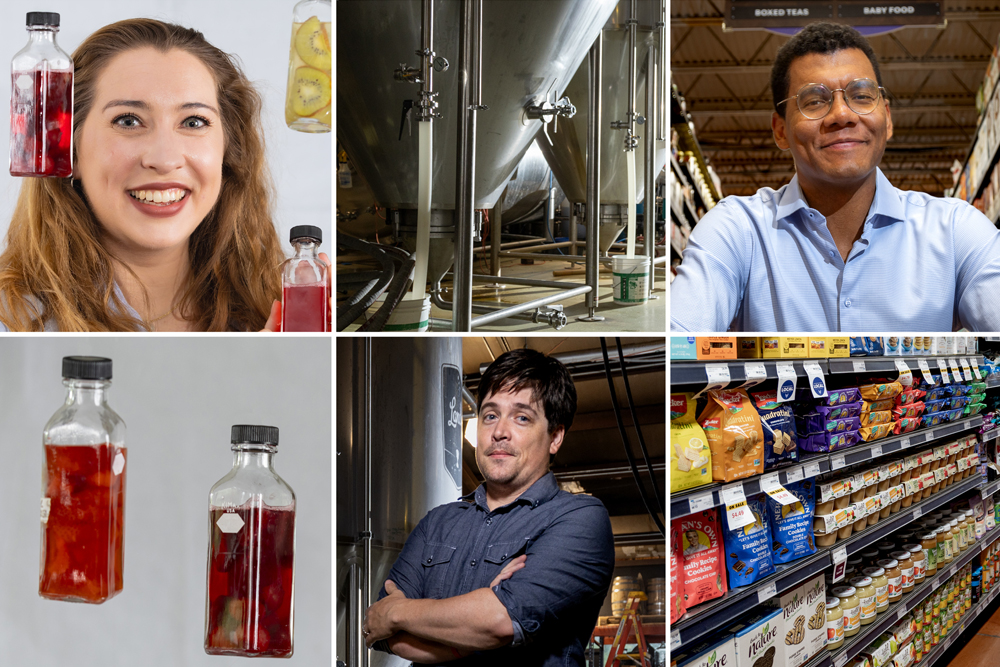A sweet-and-sour smell wafted through the halls of Peabody Hall on a humid afternoon in May. Around the corner in a nearby classroom, jar upon jar of magenta, pink, and red fluid dangled from two metal frames.
When Rachel DuMez-Kornegay coasted through the classroom door, she looked at the contraption with awe and shock. A stool sat underneath. This is where her picture would be taken. She grinned.
“I brought this just in case,” she said — and pulled out a stuffed animal of a nematode worm.
As a PhD student in the UNC School of Medicine’s genetics department, DuMez-Kornegay uses the real version of these worms to study how kombucha affects metabolism. She is one of many researchers at Carolina studying beverages — from kombucha to beer to sugary drinks like juice and soda.
Endeavors chats with three of these researchers to learn more.
The wormy wonders of kombucha

Rachel DuMez-Kornegay is a PhD student in the Department of Genetics within the UNC School of Medicine. She studies how kombucha affects gut microbiomes. (photo by Emmy Trivette)
Sour dough. Macramé. Plants. These are some of the hobbies kickstarted by the pandemic when most people were stuck at home.
Another was brewing kombucha — a fermented tea that originated in northwest China around 220 BCE and was consumed by emperors for its proclaimed detoxifying effects. It spread to other continents during World War II, gaining popularity over time in Italy, Germany, and the U.S. for its potential health benefits.
“None of these benefits have been rigorously studied in a laboratory setting,” says DuMez-Kornegay, who began brewing kombucha during the pandemic. “And the biological underpinnings of why these claims might be true are completely unknown.”
In 2020, DuMez-Kornegay was working in the Dowen lab, which studies the molecular mechanisms behind energy storage, metabolism, and fat movement. She knew that worms eat bacteria and began wondering if they’d consume kombucha. Turns out, they will.
That topic has been the focus of her thesis for the last four years. Her goal is to observe how the nematode worm called Caenorhabditis elegans, or C. elegans for short, responds to kombucha microbes.
DuMez-Kornegay chose these worms, specifically, because they can be fed a diet exclusively consisting of kombucha microbes and are an established model system to study metabolic processes. At a basic level, their nutrient sensing and cellular pathways are similar to humans. And DuMez-Kornegay is cautiously optimistic that her findings could lead to better theories on what may be going on in human digestive systems.
To run her experiments, DuMez-Kornegay makes a batch of kombucha by combining fermented kombucha from the previous brew cycle with a sweet tea media. Then, she prepares her agar petri dishes: one with the fermented kombucha and one with microbes isolated from her kombucha mixed with the sugary tea.
Soon, the feeding commences.
She feeds about 50 worms and observes differences in their biology associated with metabolism. One method to assess metabolic changes between the animals fed different diets is to stain the fat in their bodies, photograph them, and then document changes in fat storage. She discovered that the worms that consumed the fermented diet have less fat accumulation compared to those eating the non-fermented mix of microbes isolated from her kombucha.
DuMez-Kornegay’s study has wormed its way into the spotlight. In 2022, she spoke about her research in a Three Minute Thesis competition for Carolina graduate and postdoctoral students and won the Peoples’ Choice Award.
In Spring 2024, she published this work in PLOS Genetics.
“It was nice to find a place that I think appreciated all the different elements of this story that we put together,” DuMez-Kornegay says with glee.
She hopes to continue this research with another published manuscript in 2025. After graduating, she plans to pursue more studies in the probiotic, functional foods space.
“I think we’re gaining a much deeper appreciation for how vital our microbes are to our health and well-being,” DuMez-Kornegay says. “I’ll always try to find a way to stay connected with the basic science part of this field, but it’s exciting that I could keep studying probiotic products out on the market.”
Conserving water through beer

Justin Nolan is a project director at the Environmental Finance Center within the UNC School of Government. He assesses energy efficiency and water sustainability for local breweries. (photo by Emmy Trivette)
Today, North Carolina is home to 420 independent breweries, according to the North Carolina Craft Brewers Guild. In 2013, the state had 91 breweries. That’s roughly a 260% increase in a decade.
With increased production comes increased water use. While the amount of water used to make beer varies, some brewers estimate that it takes 10 gallons of water to produce one gallon of beer. And that’s just in the production process. Water is also used to wash dishes and clean the floor, countertops, and bar area.
“North Carolina is filled with water systems buckling under the weight of all of these things,” Justin Nolan says. “If I can help a brewery put less yucky stuff — that’s a technical term — into the water, then a water utility has to do less to support these guys.”
When restaurants and bars don’t know how to conserve their water, the local water utility company, and inevitably their patrons, take the hit.
Nolan is a project director at the UNC Environmental Finance Center (EFC), which conducts sustainable policy and finance research to assist communities and organizations with an array of environmental issues.
Nolan focuses on breweries, auditing their spaces and processes to help them improve their energy efficiency and water sustainability. This work is a part of the Environmental Protection Agency’s Pollution Prevention program, which provides free technical assistance to businesses who need sustainability support.
“The skepticism comes when I tell them I want to do something free for them,” Nolan says. “And I understand that. They’re entrepreneurs. But we genuinely think you’re more likely to make these changes if we tell you how to do them than if we leave you to your own devices.
Their first round of 10 audits in 2022-23 was in partnership with engineers from East Carolina University. Nolan’s preferred method of auditing a brewery is called process-mapping. This technique visually maps workflows and processes to simplify the identification of issues. To do this, Nolan asks brewers to provide their step-by-step process for how they make their beer and how the brewery is maintained, which helps him pinpoint water issues within the overall system.
“There are a lot of things caught in a process map that aren’t caught by physically exploring a brewery,” Nolan says.
For future audits, he also hopes to prioritize small communities dealing with severe environmental issues like construction and factory surplus, poor infrastructure, and clean drinking water. These are known as Environmental Justice Communities (EJC).
So far, they’ve found that many brewers in EJCs don’t respond to phone calls or emails. Nolan knows it’s likely because of time, and he understands there’s more of an impact with an in-person visit — and he can’t emphasize enough how critical conserving water is, especially in the beer industry.
“Everybody should be a shepherd of the water that they’re dealing with,” he says.
Diet disparities across the globe

Emile Charles is a rising senior in the UNC Gillings School of Global Public Health. He studies dietary inequities in communities all over the world. (photo by Emmy Trivette)
During his undergraduate career at UNC-Chapel Hill, rising fifth-year Emile Charles made it his mission to learn about dietary inequities in communities across the world.
“I take almost every opportunity I can to see a new place and learn a little bit about different cultures and communities,” Charles says with a grin. “It’s important for me because my background is such a cultural mix. I see value in what it means to be from a different place.”
The public health major got his first taste of nutritional research with the Food, Fitness, and Opportunity Research Collaborative (FFORC). Under the guidance of Carolina nutrition professor Molly DeMarco, Charles contributed to a study detailing how the FFORC practices anti-racism in their research. He has also aided their assessment of a fruit and vegetable assistance program from the COVID-19 pandemic and worked with one of their community garden partners in Hillsborough.
As an undergrad, streamlining research across a variety of projects and teams can be difficult, but Charles has found a way to do it all. While much of his work has taken place in N.C., some has sent him a little further away — to Africa and the Caribbean.
“But because of all these experiences I’ve had, I know where these data points might have come from,” Charles says. “You have a better idea about the person who purchased the food, who completed the survey, and even what the interaction between them and the cashier at the grocery store may have looked like.”
Charles’ current project takes place at the Global Food Research Program within the Carolina Population Center. The study will create a model to accurately predict children’s beverage consumption patterns using survey responses from students and schools in Kingston, Jamaica.
“We’re trying to understand how different characteristics and demographics might determine their nutritional status and what they really do consume,” Charles explains.
From 1975 to 2016, Jamaica’s obesity rate doubled, increasing from 1% to 13% in the children. Obesity is linked to cardiovascular disease, stroke, heart failure, and coronary artery disease, to name a few, so a hard look at childhood rates is critical for the long-term health of communities.
This research team wants to know which beverages schools provide, what’s marketed to children, what they’re encouraged to drink at home, and what they actually drink. Then, Charles examines data from the surveys to find common factors that significantly influence these kids’ consumption.
“This kind of work was an unintentional jump,” Charles says. “I don’t know if I intended to get super into data and food categorization, but I think I’ve learned a lot about quantitative research.”
While the last three years of his research career have provided him with a data-crunching skillset, Charles savors the fieldwork side of nutritional research and, eventually, hopes to be the type of doctor who prescribes fruits and vegetables to his patients.
“I want to consider all the inequities that might exist in food access, distribution, and knowledge,” he says.


